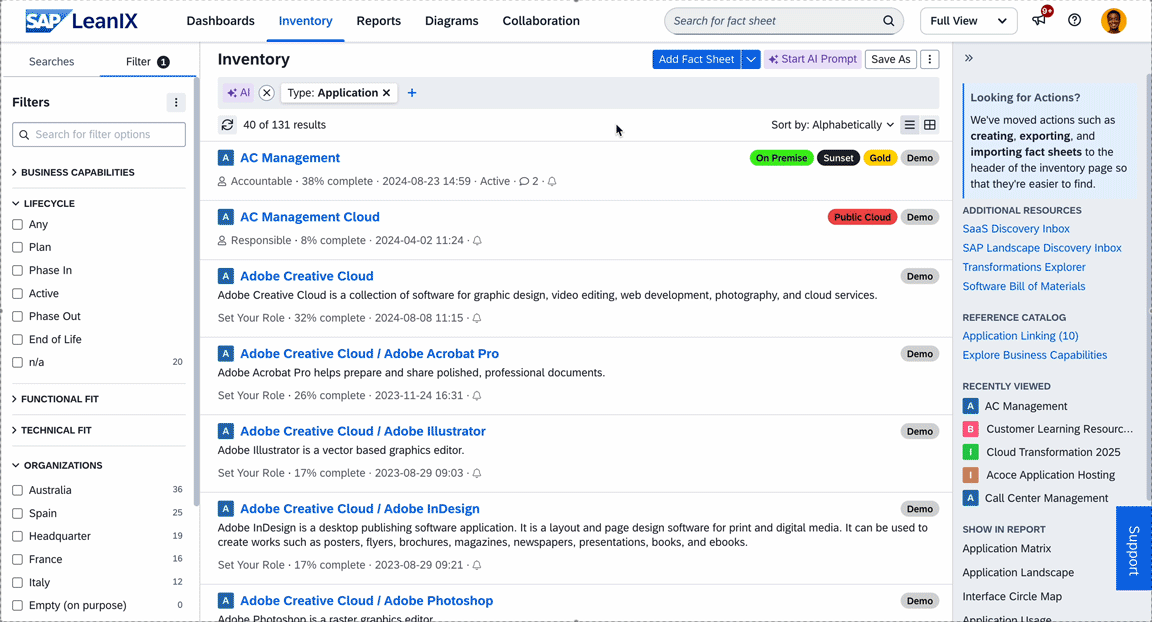Exporting Fact Sheet Data as Excel File
SAP LeanIX’s export feature allows you to export fact sheet data as an Excel file for bulk updates, easy data manipulation, and offline analysis. The exported file also serves as a template for importing data back into SAP LeanIX.
Introduction
SAP LeanIX’s export feature allows you to export fact sheet data as an Excel file. This enables bulk updates, easy data manipulation, and offline analysis, making it convenient to review large datasets outside the SAP LeanIX platform if you ever need to. Additionally, the exported Excel file serves as a template for importing data, as it includes the necessary columns for fact sheet fields in the proper format, ensuring a smooth and accurate data re-import process.
Exporting Fact Sheet Data as an Excel File
To export fact sheet data, follow these steps:
- Go the Inventory.
- Switch to table view by selecting the As Table icon. Although you can export data in list view as well, we recommend switching to table view. In table view, you can select and add specific fact sheet attributes you want to export, which isn't possible in the list view.
- At the top right of the table, click the eye icon. This opens a panel for selecting the fact sheet attributes you want to export. Each selected attribute becomes a column in the table.
Note
The columns available for selection depend on the type of fact sheet you are working with. If you haven't filtered for a specific fact sheet type, some attributes—particularly those relevant only to certain fact sheet types, like specific fields or tag groups—will not be visible or available for selection.
- From under the Inactive columns section, choose and add the column by clicking the '+' icon. You can also search for a column by its title.
- Under the Active columns section, drag and reorder the items as needed. To exclude an existing column, click 'x' next to the item.
- Hover over the three dots icon and, click Export. This opens window that provides an overview of your current export and your export history
- Choose Export.
- When the export is complete, choose Download.

Exporting Fact Sheet Data as an Excel File
Creating the Template for Import
The exported Excel file also serves as a template for importing data, as it includes the necessary columns for fact sheet fields in the proper format.
To create an import template, follow the same steps as instructed in the section Exporting Fact Sheet Data as Excel File and adhere to these best practices while preparing:
- Every attribute you add to the inventory table as a column will be a column in the exported spreadsheet. In the inventory table, include only those columns that you want to update to avoid unnecessary or accidental overwriting of other fields.
- To update fields on relations, ensure that the import template also includes a 'field on relation display name' column to identify or establish the target relation. For more, see the formatting rules for Fields on Relations.
- Create a new template for each import.
If the inventory and fact sheets already contain data, the selected columns in the exported Excel file will be partially or fully filled, and the ID column will display the fact sheet ID generated by SAP LeanIX. You can then update the data in these columns and import the file back into SAP LeanIX. To learn how to import, see Importing Fact Sheet Data Through Excel File.

The Exported Excel File Acts as an Import Template
If the inventory does not have any existing data, the exported Excel file will include only the selected column names. All other rows, starting from row 3, will be empty.
Updated about 1 month ago
